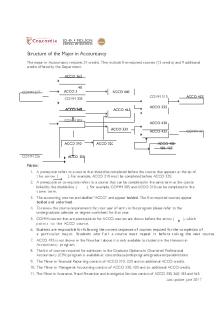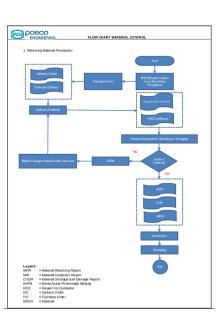Remedies Exam Flowchart PDF

| Title | Remedies Exam Flowchart |
|---|---|
| Course | The Law of Contract |
| Institution | University of Canterbury |
| Pages | 3 |
| File Size | 106 KB |
| File Type | |
| Total Downloads | 126 |
| Total Views | 224 |
Summary
Remedies Exam Template Identify the contract and that it has been breached, identify the breach. Identify any remedies available to the party Damages The primary remedy for a breach of contract is payment of damages. Damages are available to the innocent party as a right, in respect of which the mai...
Description
Remedies Exam Template 1. 2.
Identify the contract and that it has been breached, identify the breach. Identify any remedies available to the party
Damages The primary remedy for a breach of contract is payment of damages. Damages are available to the innocent party as a right, in respect of which the main purpose is to compensate for loss. 1.
Compensation for Loss a.
Compensatory Damages -
Pre Contract- Expectational (indirect) Post Contract- Consequential (direct)
- Chance Contract- Loss of a Chance As X suffered a, X can claim for – compensatory loss. X should be advised exemplary Damages not available in NZ as they are too punitive (Paper Reclaim). There is also a requirement to impose interest on damages where necessary (Money Claims Act) 2. Measurement of Loss The purpose of compensatory damages is to put the plaintiff in the position they would have been in if the breach hadn’t occurred, thus the loss must be measured. a.
Expectational Pre- Contract: When the contract did not go through William v Kirk- Seller is pulling out: difference between the contract and market value. If resale within reasonable time, damages are the difference between contract and market price (resale price), together with any consequential losses WL Thompson Purchaser is pulling out: loss of profit- difference in the contract price and cost of car to seller
b.
Consequential Post- Settlement: When the contract went through, but something went wrong a. Cost of Cure- The cost of fixing the breach b. Loss of Value- Difference between the value of what was promised and what was provided c. Loss of Amenity- Measure of enjoyment of use value (generally used when other two don’t work) Warren and Mahoney (house defective- drainage issues) Cost of cure: fixing the house (not on different land- not what was promised). Unknown how much to fix Loss of value: value of difference between current house and properly built house- $310K. Prima facie would’ve awarded cost of cure but couldn’t quantify so awarded loss of value Ruxley Electronics (wrong depth pool) Cost of cure: deepening the pool $21K Loss of value: difference in value of house with 6ft pool vs 7ft pool $0- no effect on property value Clearly a breach so not $0 $21K would over benefit so loss of amenity $2500 Contextual analysis (wasn’t a diver, didn’t matter) Do not overcompensate Marlborough District Council (vineyard with no water rights) Cost of Cure: buy water rights and build dam $1.6M Loss of Value: difference between value of property promised ($2.9M) and what was delivered ($2.55M) Awarded cost of cure- water necessary for reason brought, not reasonable to expect purchaser to relocate c. Loss of a Chance - Contract for a chance Chaplin v Hicks can still recover despite issues with evidential burden, as long as you can establish a lost chanceamount to be determined by a jury, not a judge. Strack v Grey Can be recovered when: 1. Where your benefit is gaining the chance to benefit from something (e.g. progress to the next stage) - Actionable if the chance is more than a mere possibility. - Court will determine what damages should be 2. When the outcome is dependent on the decision of an independent third party and that outcome is unknowable
Date for Measurement: loss for breach is calculated at the date of breach, unless justice requires something different (Stirling) Loss Resulting from Breach: the loss is minimum standard required to satisfy the contract- do not overcompensate (Hamilton)
3.
Consider all that are relevant…. Remoteness of Damages In order to be recoverable, the loss must not be too remote from the breach.
Old rule: Hadley two limb test NZ rule: McElroy take a multi- factorial approach and analyze all relevant factors, reasonable contemplation is always important, but not the only consideration. Directness and naturalness of the harm are significant and magnitude of the claim. Hoffman rule in Transfield: had the breaching party assumed responsibility for that loss? Interpretation of contract not test UK law unsure but unlikely Hoffman accepted. makes unclear for NZ too, so McElroy is the current law in NZ. 4.
Non- Pecuniary Loss (emotional) mental distress? Non- pecuniary loss relates to non-financial loss. The traditional English position that non-pecuniary losses are not recoverable in contract unless the purpose of the contract is to provide pleasure/ piece of mind or relaxation. In 1992, Moaut stated that these may be able to be recovered with respect to non-commercial disputes as stress is expected in commercial disputes. However, in Bloxham, the court returned to the UK position and affirmed the long-standing exception in recovery for distress, stating recovery can be admitted where the object of the contract is pleasure/ relaxation. The contract breaker is not responsible for the displeasure, nor the frustration of the other party due to policy reasons. This decision represents the current law in NZ and thus.. In 2006, the Canadian Supreme Court in Fidler allowed damages for mental distress in breach of contract. Given that there is this apex court in the English legal world deciding to award damages for mental distress, in addition to a dissent from Thomas J in Bloxham, suggests it is possible this will be re-addressed in the future. In a recent NZ HC case, Steffensen, the court awarded non-pecuniary damages. Applying Bloxham, there was no recovery available, however a contractual term designed to add additional piece of mind to the other party, meant that despite being a very monetary transaction, the court allowed $15K damages for anxiety due to coming within the exception to the general rule. This can be seen as a very broad interpretation of Bloxham. However, this decision is not binding on higher courts, so the matter is still unsettled. This could go either way but it is likely that the courts will follow the SCC decision and return back to the decision established in Moaut.
5. a. b.
c.
Factors against the Plaintif Mitigation The victim of the breach needs to take reasonable steps to mitigate (reduce) its loss (Payzu) Warren and Mahoney be careful the mitigation is reasonable Betterment Idea that sometimes a compensation for a breach can make a victim better off in some way. The idea that you can offset the betterment against other compensation (reduce compensation) J&B Caldwell only make deduction for betterment after allowance made for disadvantages to P with involuntary nature of any additional required investment due to breach Contributory Negligence applies where the basis of the breach was that party was negligent (Moaut)
Liquidated Damages (if relevant) Occurs where parties agree beforehand what sum is payable in damages in the instance of a breach. Old law: Dunlop Pneumatic Tyre Is clause is genuine pre-estimate of damages or exaggerated amount to penalize the parties. New law: Cavendish Square Holding does a contractual provision impose disproportionate detriment to any legitimate interest of the innocent party. Different to Dunlop- not strictly concerned with the damages imposed; but a broader idea of legitimate interest. Under this approach, it’s much less likely for a provision to be found to be a penalty. Trigger of when to apply the legitimate interest rule: “in the case of a breach, the breaching party is to suffer X detriment” 127 Hobson Street recently adopted Parking Eye test into law case has been appealed to SC but not yet heard Does it engage the rule? If yes.. 1. What are the legitimate interests of the innocent party? 2. Looking at the detriment, is out of proportion to legitimate interests?
6.
Cancellation Relief after one party has cancelled the contract. Technically a remedy. Specific Performance/ Injunction Equitable damages of SP and injunction are available discretionally. However, a limitation was imposed In AG v R, where it was held that specific performance and injunctions are only available when damages are inadequate. Relevant factors Use cases as authority, but also take a broad look at the facts. Conduct of the Parties What did parties do prior to court involvement? AG v R moved away from specific rules, just concerned with fairness - Even if something didn’t amount to unconscionability or undue influence it could amount to unfairness - Opportunity to take outside advice? Notice given? Kurth v McGavin change of mind cannot constitute, but state of mind could make it unequitable to be enforced- psychological pressure and drunk Effect of the Remedies on the Parties If the court were to award SP, what would the effect be? Compared with if they did not? Kurth v Mcgavin A balancing of the relative interests informed by considering the relative hardships from each party's perspective. -emotional attachment to land was considered
Personal Performance and Ongoing Relationships Lumley Court not willing to force positive SP- don’t want to be in position to make people act- can interfere with liberty. Would also require monitoring. Co-operative Insurance Society Not going to force a commercial activity that one party didn’t want Mutuality Sometimes mutuality is said to be required. In order to grant SP to one party, it must have been potentially available to the other party. Not clear how relevant anymore. AG v R One parties promise ongoing, other parties ended at the time- lack of mutuality. Account of Profits Breaching party must account to the innocent party for whatever profits were earned off the breach. AG v R account of profits only available in exceptional circumstances Declaratory Judgements Where you’re wanting to take an action based on an understanding of the contract, you can apply to the court for a declaratory order as to the meaning of a contractual provision. Not common. But possible. Limitations on Legal Remedies Six year limitation period for breach of contract...
Similar Free PDFs

Remedies Exam Flowchart
- 3 Pages

Remedies Flowchart
- 1 Pages

Remedies - Flowchart
- 1 Pages

Remedies - Complete Exam Notes
- 63 Pages

Civil Remedies Exam Template
- 11 Pages

Remedies Exam Notes/Scaffold
- 49 Pages

Remedies-Notes - exam notes
- 114 Pages

Flowchart for contract exam
- 1 Pages

Remedies-Notes - Summary Remedies
- 48 Pages

Tax-Remedies - Tax remedies
- 6 Pages

Flowchart-acco - flowchart
- 1 Pages

Flowchart
- 8 Pages
Popular Institutions
- Tinajero National High School - Annex
- Politeknik Caltex Riau
- Yokohama City University
- SGT University
- University of Al-Qadisiyah
- Divine Word College of Vigan
- Techniek College Rotterdam
- Universidade de Santiago
- Universiti Teknologi MARA Cawangan Johor Kampus Pasir Gudang
- Poltekkes Kemenkes Yogyakarta
- Baguio City National High School
- Colegio san marcos
- preparatoria uno
- Centro de Bachillerato Tecnológico Industrial y de Servicios No. 107
- Dalian Maritime University
- Quang Trung Secondary School
- Colegio Tecnológico en Informática
- Corporación Regional de Educación Superior
- Grupo CEDVA
- Dar Al Uloom University
- Centro de Estudios Preuniversitarios de la Universidad Nacional de Ingeniería
- 上智大学
- Aakash International School, Nuna Majara
- San Felipe Neri Catholic School
- Kang Chiao International School - New Taipei City
- Misamis Occidental National High School
- Institución Educativa Escuela Normal Juan Ladrilleros
- Kolehiyo ng Pantukan
- Batanes State College
- Instituto Continental
- Sekolah Menengah Kejuruan Kesehatan Kaltara (Tarakan)
- Colegio de La Inmaculada Concepcion - Cebu



